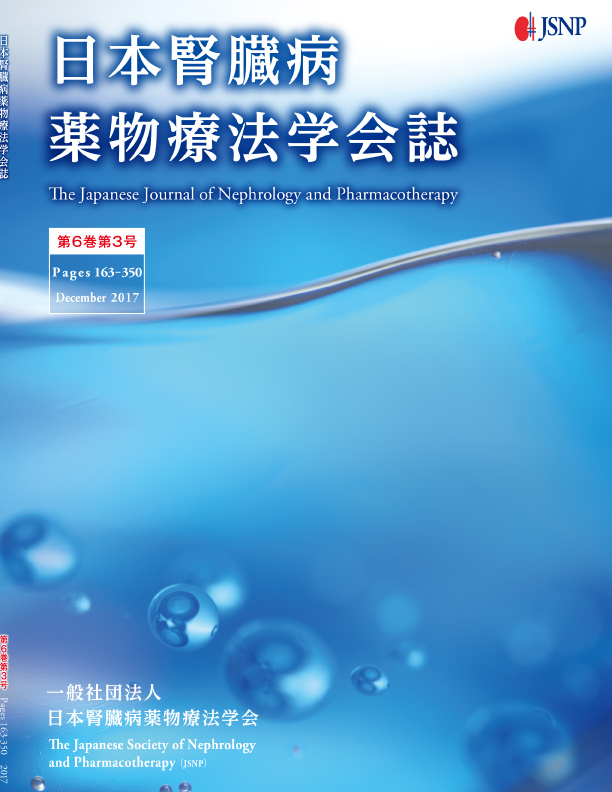
- Issue 3 Pages 319-
- Issue 2 Pages 155-
- |<
- <
- 1
- >
- >|
-
Ayako Kobayashi, Takahide Yokoyama, Kota Ishida, Kenshi Suzuki2019Volume 8Issue 2 Pages 155-162
Published: 2019
Released on J-STAGE: January 22, 2020
JOURNAL FREE ACCESSIn patients undergoing PD, blood level control after vancomycin (VCM) administration is difficult to achieve because of wide variation among individuals. Therefore, we evaluated the usefulness of a VCM clearance(CLVCM) prediction formula CLVCM(PET), which takes peritoneal equilibrium test (PET) results of PD patients into account, and a second prediction formula CLVCM(CG), which uses the CG formula, in 39 patients. Vd of VCM was set at 1.07 L/kg, and the VCM concentration data were fitted to a one-compartment model. The CLVCM value was defined as follows: CLVCM(PET) used creatinine clearance (CLcr) values of patients with a residual kidney[CLcr(R)] and those of patients undergoing PD[CLcr(PD)], defining the CLVCM value as 0.715 × CLcr(R) + 0.22 × CLcr(PD), and CLVCM(CG) defined the CLVCM value as being equal to the CLcr estimated based on the Cockcroft–Gault(CG) formula [CLcr(CG)] × 0.789. These values were used to calculate estimates. Prediction accuracy measures for estimates calculated with CLVCM(PET) and CLVCM(CG) were as follows: ME:1.5 and −0.2 μg/mL, MAE:3.8 and 3.5 μg/mL, and RMSE:5.2 and 4.6 μg/mL, respectively. In 88 % of blood levels calculated with CLVCM(PET) and 79 % with CLVCM(CG), the ratio of the predictive value to the measured value was within 0.67-1.5. Based on these results, the CG-based prediction formula appears to be easier to use and more useful.
View full abstractDownload PDF (1079K) -
Nobuyuki Doi, Hiroki Morisita, Hisayo Yokozuka, Yoichiro Takechi, Take ...2019Volume 8Issue 2 Pages 163-170
Published: 2019
Released on J-STAGE: January 22, 2020
JOURNAL FREE ACCESSIntroduction: Some over-the-counter (OTC) drugs for peptic ulcers contain sodium bicarbonate in order to neutralize gastric acid. Therefore, the ingestion of sodium bicarbonate increases the sodium intake, which is affected by salt ingestion, and these drugs must be carefully consumed. The purpose of this study was to investigate the salt-converted volume of sodium bicarbonate contained in OTC drugs for peptic ulcers and the status of information provision to customers by registered pharmacy sellers.
Methods: The salt-converted volume of sodium bicarbonate was investigated at the Self-Medication Database Center. A questionnaire survey involving registered pharmacy sellers was conducted to examine consciousness regarding the association between sodium bicarbonate contained in drugs for peptic ulcers and chronic kidney disease (CKD), as well as information provision to customers.
Results: The sodium bicarbonate content of an OTC drug for peptic ulcers accounted for 26 - 53% of the maximum daily intake, regarding the daily salt intake limit as 3 - 6 g. Furthermore, 79.2% of the registered pharmacy sellers had confirmed the drug history through “patient interviews” when selling these drugs, whereas 81.8% had never provided information or consultation services to dialysis/CKD patients. Furthermore, 20.8% had paid attention to the volume of sodium bicarbonate contained in drugs for peptic ulcers, and 15.6% recognized that 1 g of sodium bicarbonate was converted to 0.7 g of salt.
Discussion: This study demonstrated that the level of consciousness regarding the salt-converted volume of sodium bicarbonate contained in drugs for peptic ulcers was low despite “patient interviews” by the registered pharmacy sellers, and that neither information nor consultation services were frequently provided to CKD patients. Therefore, it may be necessary to educate registered pharmacy sellers through lecture meetings, pharmacist association training, and announcement of information from kidney-disease-associated societies.
View full abstractDownload PDF (1458K)
- |<
- <
- 1
- >
- >|